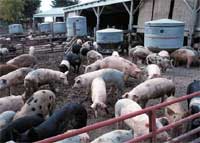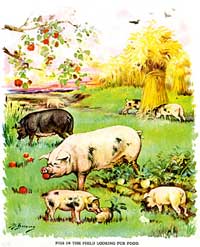
 Diet: Pigs are omnivores, which means that they consume both plants and animals. On a small farm, or in a large household, they can be fed kitchen scraps as part or all of their diet. In the wild, they are foraging animals. Pigs that are allowed to forage may be watched by swineherds. Because of their foraging abilities and excellent sense of smell, they are used to find truffles in many European countries. They are also fattened to be eaten as ham and other types of meat, such as bacon. Diet: Pigs are omnivores, which means that they consume both plants and animals. On a small farm, or in a large household, they can be fed kitchen scraps as part or all of their diet. In the wild, they are foraging animals. Pigs that are allowed to forage may be watched by swineherds. Because of their foraging abilities and excellent sense of smell, they are used to find truffles in many European countries. They are also fattened to be eaten as ham and other types of meat, such as bacon.
Pigs are highly trainable animals, and some, such as the Asian pot-bellied pig, are kept as pets. A litter of piglets typically contains between 6 and 12 animals. Occasionally, in captivity, pigs may eat their own young.
Sweat: Pigs do not sweat (they do not have similar sweat glands), and cool themselves using water or mud during hot weather. They also use mud as a form of sunscreen to protect their skin from sunburn.
Possible Advertisement
Domestic pig: The domestic pig (Sus scrofa domesticus) is usually given the scientific name Sus scrofa, though some authors call it S. domesticus, reserving S. scrofa for the wild boar. It was domesticated approximately 5,000 to 7,000 years ago. Pigs are found across Europe, the Middle East and extend into Asia as far as Indonesia and Japan. The distinction between wild and domestic animals is slight, and domestic pigs have become feral in many parts of the world (for example, New Zealand) and caused substantial environmental damage.
Sus scrofa has four subspecies, each occupying distinct geographical areas:
* Sus scrofa scrofa (western Africa, Europe)
* Sus scrofa ussuricus (northern Asia and Japan)
* Sus scrofa cristatus (Asia Minor, India)
* Sus scrofa vittatus (Indonesia)
 History: Pigs are one of the oldest forms of livestock, having been domesticated as early as 5000 BC. It is believed to have been domesticated either in the Near East or in China from the Wild Boar. The adaptable nature and omnivorous diet of the Wild Boar allowed early humans to domesticate it much earlier than many other forms of livestock, such as cattle. Pigs were mostly used for food, but people also used their hide for shields, their bones for tools and weapons, and their bristles for brushes. Pigs were brought to southeastern North America from Europe by De Soto and other early Spanish explorers. Escaped pigs became feral and were freely used by Native Americans as food. History: Pigs are one of the oldest forms of livestock, having been domesticated as early as 5000 BC. It is believed to have been domesticated either in the Near East or in China from the Wild Boar. The adaptable nature and omnivorous diet of the Wild Boar allowed early humans to domesticate it much earlier than many other forms of livestock, such as cattle. Pigs were mostly used for food, but people also used their hide for shields, their bones for tools and weapons, and their bristles for brushes. Pigs were brought to southeastern North America from Europe by De Soto and other early Spanish explorers. Escaped pigs became feral and were freely used by Native Americans as food.
Intelligence: Pigs are known to be intelligent animals and have been found to be more trainable than dogs or cats. Asian pot-bellied pigs, a smaller subspecies of the domestic pig, have made popular house pets in the United States beginning in the latter half of the 20th century. Regular domestic farmyard pigs have also been known to be kept indoors, but due to their large size and destructive tendencies, they typically need to be moved into an outdoor pen as they grow older. Most pigs also have an extreme fear of being picked up, but will usually calm down once placed back on the floor.
All text is available under the terms
of the GNU Free Documentation License
|